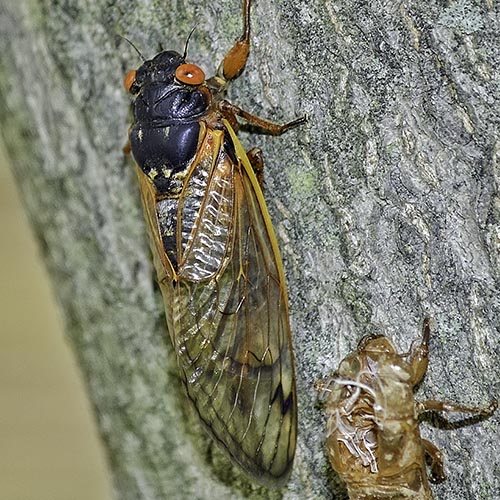
Listen to this Episode:
- From this webpage:
- Find the media player located under the episode picture.
- Click on the green triangle to listen to the audio for this episode.
- From your favorite podcast listening platform:
- Search for “Backyard Ecology.”
Show notes:
For many of us, the rhythmic chatter of annual cicadas is a natural part of every summer. But then… every once in a while… the trees explode in a deafening chorus of periodical cicadas. Periodical cicadas will spend over a decade as nymphs underground before emerging and maturing into adults. The adults only live a few weeks, but what an impression they make while they are here!
In this episode of the Backyard Ecology podcast, we talk with Dr. Gene Kritsky. Gene is the Dean of the School of Behavioral and Natural Sciences at Mount St, Joseph University in Cincinnati. He is also the author of the book Periodical Cicadas: The Brood X Edition.
During our conversation, Gene talked about the different species of 17-year periodical cicadas, as well as, the difference between broods and species. We also talked about the interesting life history of periodical cicadas and the important roles they play in the local ecosystems when they emerge. In addition, Gene provided tips for anyone who might be a little concerned about any negative impacts that periodical cicadas might have on their trees.
One of the most exciting things Gene shared with us is his research on documenting and mapping the different broods. The idea that whole broods could be missed for centuries or that we have new broods appearing as portions of known broods shift their emergence patterns is fascinating to me. I also love the fact that he has given all of us the opportunity to help document and map the different broods through his Cicada Safari app.
Using the Cicada Safari app, we can help Gene and other researchers gain a better understanding of the distribution of the different broods. With today’s tools and technology, we have the opportunity to easily help create much more detailed and comprehensive maps of the broods than scientists have ever been able to do before. But to it will take all of us working together and documenting what is happening in our own yards and communities. I think that’s exciting and hope we can help grant Gene’s wish to completely overwhelm him with data.
I also appreciate all of the fun and educational resources that are included in the Cicada Safari app and on the Cicada Safari website. Whether you want to learn how to identify the different species, just have some fun making origami cicadas, learn how to dive into the historic records to try and identify overlooked broods in your area, or are looking for potential science fair project ideas, the Cicada Safari website has you covered. Links to the Cicada Safari website, Gene’s book, and other periodical cicada resources he recommended can be found below.
When we recorded this in 2021, Brood X was the periodical cicada emergence that we were looking forward to. However, at least one brood of periodical cicadas emerges somewhere in the country every year. So, no matter when you listen to this episode, it is likely that there will be an emergence somewhere in the U.S. that needs to be documented and mapped.
Links:
- Cicada Safari
- Periodical Cicadas: The Brood X Edition
- Other recommended resources
- Backyard Ecology’s website
- My email: shannon@backyardecology.net
* Amazon links are affiliate links and I earn a small commission from qualifying Amazon purchases made the link. The commission is paid by Amazon and comes at no extra cost to you, but helps support the costs associated with hosting the Backyard Ecology blog, podcast, and website.
Episode image:
- Periodical cicada
- Photo credit: Gene Kritsky, Mount St. Joseph University, all rights reserved

Backyard Ecology: Exploring Nature in Your Backyard
Nature isn’t just “out there.” It’s all around us, including right outside our doors. Hi, my name is Shannon Trimboli, and I am the host of Backyard Ecology. I live in southcentral Kentucky and am a wildlife biologist, educator, author, beekeeper, and owner of a nursery specializing in plants for pollinators and wildlife conservation. I invite you to join me as we ignite our curiosity and natural wonder, explore our yards and communities, and improve our local pollinator and wildlife habitat. Learn more or subscribe to my email list at www.backyardecology.net.

Leave a Reply